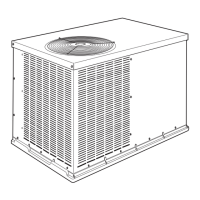19
Table 8—Wet Coil Pressur e Drop
UNIT
SIZE
STANDARD CFM (S.C.F.M.)
600 700 800 900 1000 1100 1200 1300 1400 1500 1600 1700 1800 1900 2000
024 .027 .034 040 .047 .053 -- -- -- -- -- -- -- -- -- --
030 -- .036 .042 .050 .055 .063 .072 .081 -- -- -- -- -- -- --
036 -- -- -- .050 .055 .063 .072 .081 .090 .097 -- -- -- -- --
042 -- -- -- -- .042 .049 .052 .059 .065 .071 .078 .085 .091 -- --
048 -- -- -- -- -- -- .072 .081 .090 .097 .108 .120 .129 .139 --
060 -- -- -- -- -- -- -- -- -- .071 .078 .085 .091 .098 .114
Ta ble 9—Filter Pressure Drop (in. wg)
UNIT SIZE
FILTER
SIZE
(in.)
CFM
500 600 700 800 900 1000 1100 1200 1300 1400 1500 1600 1700 1800 1900 2000 2100 2200 2300
024--036 24 x 24 0.06 0.07 0.08 0.08 0.09 0.09 0.09 0.10 0.11 0.12 0.14 0.15 — — — — — — —
042--060 30 x 30 — — — — — — — — 0.08 0.09 0.10 0.11 0.12 0.13 0.14 0.15 0.16 0.17 0.18
Table 10—Accessory Electric Heat Pressure Dr op (in. wg)
HEATER kW
CFM
600 800 1000 1200 1400 1600 1800 2000 2200
5--20 0.06 0.08 0.10 0.13 0.15 0.18 0.20 0.23 0.25
e. Center the wheel in the housing by sliding it,align theflat
end of the shaft with the set screw and tighten the set
screw .
f. Slide back the blower housing into the mounting rails in
the duct panel and install the mounting bracket back in its
position.
g. Install the screws on the external side of the duct panel to
fasten duct panel with the housing.
h. Replace the side access panel.
Step 4—Outdoor Coil, Indoor Coil, and Condensate Drain
Pan
Inspect the condenser coil, evaporator coil, and condensate drain
pan at least once each year.
The coils are easily cleaned when dry; therefore, inspect and clean
the coils either before or after each cooling season. Remove all
obstructions, including weeds and shrubs, that interfere with the
airflow through the condenser coil.
Straighten bent fins with a fin comb. If coated with dirt or lint, clean
the coils with a vacuum cleaner, using the soft brush attachment. Be
careful not to bend the fins. If coated with oil or grease, clean the
coils with a mild detergent and water solution. Rinse coils with clear
water, using a garden hose. Be careful notto splashwater on motors,
insulation, wiring, or air filter(s). For best results, spray condenser
coil fins from inside to outside the unit. On units with an outer and
inner condenser coil, be sure to clean between the coils. Be sure to
flush all dirt and debris from the unit base.
Inspect the drain pan and condensate drain linewhen inspecting the
coils. Clean the drain pan and condensate drain by removing all
foreign matter from the pan. Flush the pan and drain trough with
clear water. Do not splash water on the insulation, motor, wiring, or
air filter(s). If the drain trough is restricted, clear it with a “plumbers
snake” or similar probe device.
Step 5—Outdoor Fan
UNIT OPERATION HAZARD
Failure to follow this caution may result in damage to unit
components.
Keep the condenser fan free from all obstructions to ensure
proper cooling operation. Never place articles on top of unit.
CAUTION
!
1. Shut off unit power supply and install lockout tag.
2. Remove outdoor-- fan assembly (grille, motor, motor cover,
and fan) by removing screws and flipping assembly onto
unit top cover.
3. Loosen fan hub setscrews.
4. Adjust fan height as shown in Fig. 19.
5. Tighten setscrews.
6. Replace outdoor--fan assembly.
12m
A06411
Fig. 19 -- Outdoor Fan Adjustment
Step 6—Electrical Controls and Wiring
Inspect and check the electrical controls and wiring annually. Be
sure to turn off the electrical power to the unit.
Remove access panel to locate all the electrical controls and wiring.
Check all electrical connections for tightness. Tighten all screw
connections. If any smoky or burned connections are noticed,
disassemble the connection, clean all the parts, re-- strip the wire end
and reassemble the connection properly and securely.
Check to ensure no wires are touching refrigerant tubing or sharp
sheet metal edges. Move and secure wiresto isolate from tubing and
sheet metal edges.
After inspecting the electrical controls and wiring, replace all the
panels. Start the unit, and observe at least one complete cooling
cycle to ensure proper operation. If discrepancies are observed in
operating cycle, or if a suspected malfunction has occurred, check
each electrical component with the proper electrical
instrumentation. Refer to the unit wiring label when making these
checks.
Step 7—Refrigerant Circuit
Inspect all refrigerant tubing connections and the unit base for oil
accumulation annually. Detecting oil generally indicates a
refrigerant leak.
If oil is detected or if low performance is suspected, leak test all
refrigerant tubing using an electronic leak detector, or liquid-- soap
50ZPA50ZPA

